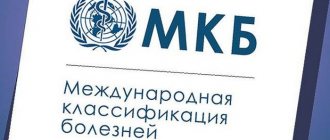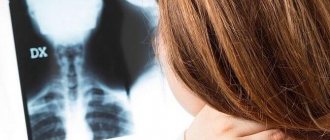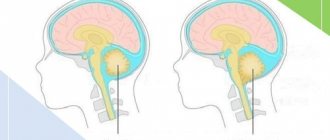Abdominal migraine (psychogenic abdominal pain) is an idiopathic, relapsing disorder mainly affecting children and adolescents and characterized by episodic abdominal pain in the midline or around the umbilicus, which occurs during attacks.
Between attacks the disease is asymptomatic. The intensity of the pain is quite strong, capable of affecting daily activities, and is accompanied by vasomotor symptoms (pallor, dark circles under the eyes, less often redness), nausea and vomiting. An abdominal migraine attack lasts 1-72 hours, usually about 1-2 hours.
The first migraine attacks occur mainly in childhood or adolescence, in 20% of patients before 10 years of age, and in 45% before 20 years of age.
The first attacks occur more often in boys than in girls (the average age of onset of migraine in males is 7.2 years, while in females it is 10.9 years).
The prevalence of the disease before puberty is higher among boys than among girls; during puberty, the ratio changes, and at the age of 20, women suffer from migraine 2 times more often than men; at a later age, the predominance of women increases 3 times.
Causes of the disease
The specific cause of abdominal migraine is unknown. The occurrence of pain syndrome is based on a hereditary predisposition. If parents have pathology, the risk of its occurrence in children increases several times.
Pathology is often noted in childhood. In this case, the child is restless, he has emotional lability and increased anxiety. The risk of developing the disease increases with an unstable situation in the family - frequent conflicts, the presence of psychosis and other disorders in parents. In this regard, abdominal migraine is regarded as a disease with a genetic predisposition, which is realized against the background of environmental factors.
The occurrence of pain syndrome is noted in the following situations:
- pronounced emotional stress, positive or negative;
- severe or chronic stress;
- constant physical fatigue;
- insomnia and other sleep disorders.
When collecting anamnesis, a number of patients note that abdominal pain appears after taking certain foods. Most often these are dark chocolate, nuts and fatty fish.
Development mechanisms
There are no organic changes in the organs of the gastrointestinal tract and nervous system, and therefore it is not possible to establish the site of development of the disease. A number of scientists believe that pain occurs as a result of a violation of the innervation of the intestine. This may be due to disturbances in the embryonic development of neural elements.
A known trigger for abdominal migraine symptoms is stress. It is believed to lead to increased release of neurotransmitters by neurons in the brain stem. Their imbalance disrupts the functioning of the centers that regulate blood supply and motility of the gastrointestinal tract, causing pain.
When neurotransmitter imbalances occur again, nerve cells “remember” the connection between stress and pain. As a result, any discomfort can lead to a migraine attack.
What causes the disorder?
The causes and mechanisms of abdominal migraine are poorly understood to date. According to some experts, they may be associated with endocrine and neurological disorders in the body, including fluctuations in histamine and serotonin levels.
Genetic factors also play an important role. About 60% of children suffering from abdominal migraine attacks have a positive family history of the disease (up to 90% in the first degree).
Triggers for this form of migraine may be the same as for classic migraine; these include chocolate, stress and anxiety, caffeine, amines, irregular diet and poor sleep patterns.
Clinical manifestations
In 3 out of 4 patients, symptoms of abdominal migraine occur in the morning. In some cases, precursors are possible: lability of mood and behavior, a feeling of general weakness and increased fatigue. Such changes are observed within a couple of hours or days.
Abdominal migraine in adults and children is characterized by causeless pain in the middle abdomen. The frequency of their appearance is from several days to several months. The intensity of pain varies. Most patients note that the sensations are moderate and localized in the navel area. In some patients, the pain is diffuse and can be severe. The pain syndrome is accompanied by general weakness and dyspeptic disorders, which can simulate diseases of the abdominal organs: acute appendicitis, cholecystitis, etc.
Adult patients try to move less and take a forced lying position. Adolescents may experience hyperactivity associated with abdominal discomfort and pain. Abdominal migraine in childhood is characterized by emotional lability and tearfulness.
Due to disturbances of autonomic innervation, patients experience pale skin, bloating, flatulence and nausea. Pain and these symptoms persist from 1 to 72 hours, after which they disappear without a trace. The number of pain attacks during the year can reach 200 or more. A characteristic feature of the disease is the appearance of classic migraine with headache, the frequency of which gradually increases.
How to relieve an attack
To improve the child’s well-being and relieve severe pain, it is recommended to put him to bed. It is advisable to first ventilate the room well to ensure access to fresh air. The child needs to create a calm and comfortable atmosphere. It is recommended to apply a cool compress to the forehead.
A light massage of the temporal and occipital parts of the head will help to cope with painful sensations. The movements performed should be as relaxing as possible. During a severe attack, vomiting can relieve the child's condition. However, if there is nausea, but there is no vomiting itself, you can induce it yourself by giving your child boiled, lightly salted water to drink.
Diagnostic measures
Making an accurate diagnosis requires a comprehensive diagnosis and exclusion of all other diseases that lead to abdominal pain. The difficulty of diagnosis is due to the fact that many doctors are not aware of this pathology and do not detect it in children and adults.
Diagnostic measures are carried out according to the following algorithm:
- The doctor collects all existing complaints, how long ago they appeared, and also finds out the provoking factors that the patient himself identifies. It is important to clarify the presence of accompanying symptoms - nausea, vomiting, blanching of the skin, etc. The specialist takes into account the existing pathologies of the gastrointestinal tract and the treatment provided for them.
- A general examination and physical examination of the abdominal organs is carried out by a therapist or gastroenterologist. Symptoms of the disease are not detected - palpation of the abdomen is painless, the abdominal muscles are relaxed, the intestinal loops are within normal limits on palpation. If the examination is carried out during an attack, then there is increased sensitivity of the skin of the abdomen to touch.
- Clinical analysis of blood, urine and stool examination - without pathology. To exclude diseases of the pancreas, amylase in the blood is determined. Studying the levels of AST, ALT and bilirubin allows us to assess the condition of the liver. Pathological microflora is not detected by stool culture.
- The condition of the abdominal cavity and internal organs is assessed using ultrasound. Pathological changes are not typical. In the presence of concomitant kidney diseases, ultrasound can be combined with excretory urography and other methods of examining the urinary system.
- The differential sign of abdominal migraine is increased blood flow in the abdominal aorta during an attack. The study is carried out using ultrasound with Doppler sonography.
- To exclude developmental anomalies and organic diseases of the small and large intestines, the patient undergoes an X-ray examination with contrast. This method is necessary for differential diagnosis with intestinal obstruction, nonspecific ulcerative colitis and tumor lesions of the gastrointestinal tract.
If pain in the abdomen is combined with a headache, then the patient undergoes magnetic resonance imaging. MRI of the brain allows us to exclude neoplasms, hydrocephalus, ischemic damage to nerve structures, etc.
The diagnosis of abdominal migraine can be made if the following diagnostic criteria are met:
- painful attacks in the abdominal area lasting no more than three days (the frequency of pain does not matter);
- the presence of 2 or more symptoms from the following list: general weakness, pale skin, nausea and vomiting.
Differential diagnosis should exclude bacterial and viral intestinal infections, enteropathies, surgical pathologies of the abdominal organs, functional disorders, diseases of the kidneys and reproductive system.
Diagnostics
For treatment of a disease to be effective, it is very important to establish its causes. To do this, you need to promptly consult a doctor who will analyze the symptoms of the disease and conduct a thorough diagnosis.
First, the child must undergo a comprehensive examination to exclude pathologies of the genitourinary system, digestive organs, heart and blood vessels. If there are no abnormalities in the baby’s health, but the pain is periodic, the doctor may suspect abdominal migraine.
To make an accurate diagnosis, the doctor prescribes the following tests:
- general tests of urine, blood, feces;
- palpation of the abdomen;
- taking anamnesis;
- electroencephalogram;
- Dopplerography of the vessels located in the abdominal cavity.
Abdominal migraine always has a neurological origin, so the pathology is treated by a neurologist.
Treatment approaches
Treatment of abdominal migraine is similar to treatment of the cephalgic form of the pathology. It includes taking medications to relieve acute pain attacks, as well as ongoing prevention.
Treatment during an exacerbation
The main goal of therapy during this period is to eliminate pain. Painkillers are used for this purpose. Simple analgesics (Analgin, Baralgin, etc.) are not effective. Preference is given to non-steroidal anti-inflammatory drugs - Ketorol, Nise, Ibuprofen, etc. They relieve pain and are highly effective. A good effect is observed when using Paracetamol. The medication is classified as an antipyretic, however, it has an analgesic effect on the body.
Nonsteroidal anti-inflammatory drugs
The use of triptans (Eletriptan, Sumatriptan), used for typical migraines, also provides rapid relief from pain in the patient. The drugs act on serotonin receptors in the brain and normalize their tone. It is important to note that this group of drugs should not be used in children due to the lack of evidence of their safety. Pediatricians can use drugs based on valproic acid, which are administered intravenously.
Symptomatic therapy is mandatory:
- for vomiting and nausea, antiemetics are prescribed (Metoclopramide, Cerucal);
- hyperthermia is an indication for the use of antipyretics - Paracetamol and its analogues.
All medications should be used only after being prescribed by the attending physician. Medicines have a number of indications and contraindications, non-compliance with which can cause the development of side effects and progression of the underlying disease.
Treatment during the interictal period
How to treat abdominal migraine in the period between exacerbations to reduce their number? The main task of prevention is to eliminate trigger factors in the form of stress, overwork in school, heavy sports, etc. The pediatrician must talk with the child’s parents and with the child himself, explaining the causes of pain and talking about how to prevent it.
Doctors make a number of preventive recommendations:
- Normalization of sleep and rest patterns. The child should sleep at least 8-9 hours during the day. An adult – at least 7-8 hours.
- Eliminating stressful situations from life, restoring a healthy psychological climate in the family.
- Limiting heavy physical activity, primarily in children and people actively involved in sports.
- Switch to a balanced diet rich in vitamins and microelements. The diet should include a large amount of vegetables, fruits, berries and nuts.
The development of exacerbations can be prevented by using medications. For this purpose, Propranolol and sedative medications are prescribed. They should be used in therapeutic dosages approved by the attending physician.
Treatment options for abdominal migraine
This disease has a course uncharacteristic of simple migraines, which very often makes it very difficult to identify the correct diagnosis. The main problem of timely treatment is that children under 7 years of age who complain of severe abdominal pain, after an initial examination by a specialist, are almost always hospitalized in a hospital, where they often receive proper treatment.
In the event that the results of the study do not reveal significant symptoms for such attacks, and also if characteristic signs of migraine occur, it is important that the patient is examined by a pediatric neurologist.
If the suspicion is confirmed, it will be necessary to carry out appropriate therapeutic and preventive procedures, which consist of a combination of medicinal and preventive methods of treatment for the disease of the little person.
Possible complications
Abdominal migraine, occurring in childhood, leads to missed visits to kindergarten and school. This can cause delayed psycho-emotional and intellectual development, especially with a high frequency of pain attacks. Frequent pain leads to the formation of asthenic syndrome in the patient, which is characterized by increased fatigue, low ability to concentrate and perform any work. Children may develop neurasthenia, depression and hypochondria. Such personality changes are not always associated with illness and can be considered as psychological characteristics of the child.
Negative consequences in pathology may be associated with incorrect diagnosis and prescription of therapy. If acute abdomen and appendicitis are suspected, unnecessary surgical intervention is performed, which creates additional health risks in the form of infection of the surgical wound, internal bleeding, etc. When diagnosing an intestinal bacterial infection, antibiotics are prescribed, the use of which is fraught with the development of dysbacteriosis, which is difficult to treat.
Forecast
In most pediatric and adult patients, the disease is benign. Timely elimination of an acute attack and prevention of relapses allows you to control the course of the disease. In 20-30% of cases of abdominal migraine in children, recovery occurs after adulthood.
Against the background of a long-term pathology, the development of the classic cephalgic form of migraine is possible. Gradually, abdominal manifestations completely disappear. The number of migraine attacks against the background of adequate therapy is minimal, even completely absent.











